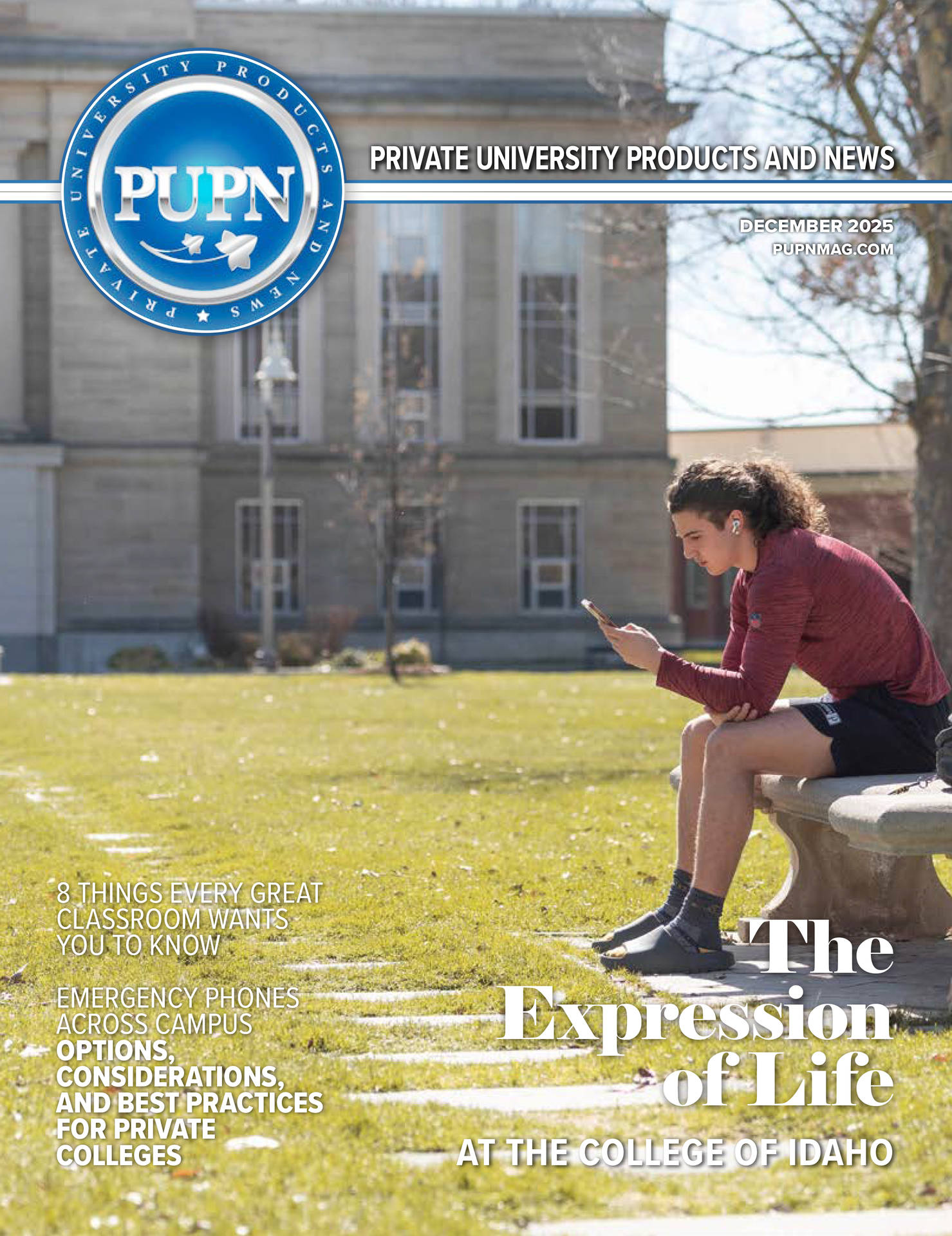There are many different approaches to protecting students, faculty, and staff on campus. Campus safety technology has grown into a $2.7 billion industry as of 2024. The technology ranges from simple, smartphone-based GPS monitoring to more advanced security measures like IPS systems that map out entire buildings. Using a combination of strategies gives institutions the best chance of bolstering security and keeping campus communities safe. What follows is a survey of how available technologies are helping college public safety teams ease concerns about the safety of our campuses.
Access Control Systems and IP-Enabled Cameras
Access control systems make for effective first lines of defense on school grounds. Without them, residence buildings, lecture halls, and administrative buildings are more susceptible to potential intruders. Student-restricted areas, closed off for safety concerns, can also be kept locked and inaccessible. If emergency help is delayed for any reason, the system’s monitoring grants designated personnel access to lock or unlock doors remotely. At a higher level, knowing which system or doors trigger alarms grants situational awareness to those responding to emergencies—an asset previously unavailable without the technology.
Unlike traditional analog cameras that have lower frame rates, coverage, and resolution, IP-enabled cameras have multiple sensors and the power to detect motion and smoke, track people in frame, and set off alarms as necessary. IP-enabled cameras also tilt to cover greater areas and deliver improved resolution. They can detect crucial details of intruders and crimes that were previously unavailable, such as distinct facial features, clothing details, and car license plates.
Gunfire Detection Systems, GIS, and IPS
Having the ability to detect gun violence threats immediately, perhaps even before they cause irreversible harm, is a gamechanger for first responders. We now have access to special sensors that identify gunshots and alert the correct personnel instantly. Sensors can detect the number of shots fired and the type of weapon used, and they can provide a detailed map tracking the shooter’s location. Supplied with this information, law enforcement can then make informed decisions about dispatching response while disseminating vital information to students, faculty, and staff.
Understanding location is key during such emergencies. Geographic information systems (GIS) and indoor positioning systems (IPS) save emergency responders invaluable time by providing spatial context about environments, even showing blueprints and 3-D imagery of an area where a threat is taking place. Emergency personnel can use this technology to easily locate doors and windows to gain entry. The location of key players in incidents can be pinpointed in real time without verbal or direct communication. GIS and IPS are especially useful in multistory buildings, where identifying where an emergency has been triggered can be much more challenging without the right technology.
Mass Notification Systems and Safety Apps
The ability to call or text every student on campus simultaneously is a mainstay of emergency responses. Notification systems can inform students of when, where, and what is happening during an emergency. Crucially, they also provide information on how best to respond in the moment. Innovators of mass notification systems have also recognized that not everyone owns a smartphone, or that phones may be turned off during exams or in quiet learning environments. In such cases, campus security now has the capability of sending mass alerts to every desktop computer in the school network. This allows authorities to notify students of severe weather conditions, active shooters, or Amber alerts, for example.
Using safety features built into a campus’ dedicated app, or simply training students and faculty to use other safety apps, can empower those directly affected by an emergency at a time when their needs are most urgent. These measures grant students and faculty peace of mind, knowing that if they ever feel unsafe on campus, they can use in-app features to call for help or report an event. Panic buttons in apps, as well as text-to-911 capabilities within them, discreetly connect people in danger to those who can help when calling 9-1-1 isn’t an option. Many apps also include the option to share location information, which is then stored by a secure server for law enforcement to review. Alert systems for reporting crimes do their part in letting users report incidents, as well. Schools can subscribe to advanced security apps so users can take videos or discreetly record audio clips.
Smart Identification Cards and Intelligent Lockers
Another type of technology advancing campus security is smart identification. Most schools already use a student ID card system; creating cards embedded with memory chips is the next logical step in safety. These smart cards allow students to access buildings and can even serve as bus passes and debit cards. Smart IDs are also difficult to forge due to their embedded memory chip. Anyone without a card may trigger an alarm when entering a campus building uninvited.
Secure package delivery and pickup systems can reduce incidents of theft. Intelligent lockers assign a unique QR code to anyone picking up a package. When a delivery is retrieved, the barcode automatically opens a locker door containing only the recipient’s mail. The recipient then digitally signs for the package. This self-service system operates night and day, allowing students to securely pick up packages without the risk of someone stealing them. Campuses can also install cameras around the lockers for additional security.
Visitor Management Software
A log that shows who visits and departs campus property is a crucial security feature. Visitor management software takes the classic paper sign-in sheet a step further by documenting everyone on campus and letting them enter buildings with a digital access code on their phone. When visitors leave campus property, the system automatically signs them out and removes their access code. Administrators can combine visitor management software with remote cloud-based technologies to operate door locks, look through security cameras, view security information, and send mass notifications to students and faculty with a click of a button.
Best Practices for Event Security
Universities and colleges regularly invite public on campus to attend large-scale events such as graduation ceremonies, athletic events, and special speaker sessions. These events pose a challenge for campus security professionals. For instance, the perimeter security of a larger scale event can be porous, and security coverage may be limited; the larger and more open the event is, the more difficult it is to secure and protect. The variety of possible types of emergency scenarios makes preparing for them problematic, as well. Whether a school event attracts hundreds or thousands, adding security personnel is a must. Security should be considered in the planning stages for an event to include emergency services. The overt presence of security personnel not only works as a possible deterrent to potential perpetrators, but it also conveys to guests that they’re in a safe environment.
An established security perimeter with easily recognizable entry and exit points goes a long way in meeting security needs. Policies that avert problems at the point of entry are also essential, those such as bag and package search, in/out return procedures for patrons, and posted conduct rules. Security communication equipment procedures help security teams maintain operational contact when an incident occurs. Public address and mass notification systems help communicate vital information in the event of an emergency. Modern IP camera technology is particularly useful during large events. These devices can analyze terabytes of video from hundreds or thousands of network-attached cameras. Moreover, advanced search tools can lead security teams to precisely the incident in need of review. Modern IP camera technology can even use AI and deep learning to create searchable footage that recognizes and extracts objects. Whether it’s counting cars, people, backpacks, or line crossing, operators can use video content analytics platforms to create a customizable search and report results. Aggression detection is a necessary video analytic in areas where the public interacts. For example, audio sensors can monitor sound while listening for raised voices, shouting, or keywords from passersby. An alert notifies monitoring personnel when aggression occurs. As a result, security teams can initiate a proactive response. Some sensors can pick up key phrases, such as “Call 9-1-1” or “Help.” In addition, the audio analytics can tag video associated with the audio, triggering the notification to operators.
College event security is a big challenge for campuses everywhere. The single best practice for those who are planning a large-scale event is to plan early and thoroughly for the event. A comprehensive emergency plan and the adoption of safety technologies help security teams prepare, respond, and even prevent incidents that may pose a safety risk.
Having safety technology and protocol in place for the protection of students, faculty, staff, and visitors is critical for peace of mind across campus, whether it’s an ordinary day of classes or a special occasion with large groups who aren’t normally on campus coming to visit. Students and parents want to know before committing to a school that its leaders prioritize security and have taken steps to demonstrate their dedication. No one likes to think about crime on campus, but the good news is that technology and best practices have evolved to limit vulnerabilities.










